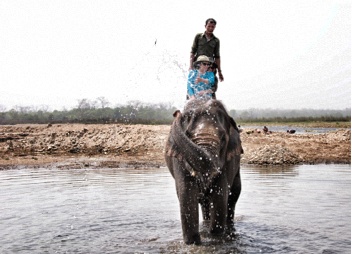by Jane Spencer
“Guess what? I rode an elephant in Nepal!”
 My five-year-old grandson was not impressed. “You rode one of those dirty, smelly things?” He’s very sensitive to unfamiliar odours and textures.
My five-year-old grandson was not impressed. “You rode one of those dirty, smelly things?” He’s very sensitive to unfamiliar odours and textures.
“Well, we gave her a bath,” I elaborated, over the phone.
Weeks later, I was still thrilled with my visit to Chitwan National Park in Nepal. The park, located in the terai or subtropical lowlands of the country, is a UNESCO World Heritage Site with a diversity of ecosystems (forests, ox-bow lakes and flood plains), animals (rhinos, sloth bears, deer, crocodiles), and birds (hornbill, kingfishers and peacocks). Elephant numbers there have grown to fifty. They live in a protected environment in exchange for safari labour, with a guarantee they won’t be transported to zoos or hunted for ivory.
It was my first safari and my first contact with elephants. Our group of four was guided to a platform with stairs which we took turns mounting, before lowering ourselves into a box frame roped around the elephant’s girth. The elephant trainer, or mahout, wielded his sharp metal hook and shouted an order, then we were off into the grasslands to search for one-horned rhinos, and maybe, if we were lucky, a Bengal tiger.
Our (Asian) elephant was a 35-year-old female named Puja Kali. The box seat rocked and tipped in tune with her giant steps, our feet dangling loose. It was not always a comfortable ride. I kept knocking into elbows, bruising my arms on the wooden edges, giggling and getting shushed by my safari-mates.
After twenty minutes of this, the mahout leaned out and pointed at something ahead. I could see three grayish heads lurking in the grass -- one-horned rhinos. We approached and watched silently from our perch, hoping for some wildlife action. The rhinos looked up from their munching, stared at us briefly, then presented us with armoured backsides as they resumed dinner. They sensed no danger, as we were only out for photos and not interested in the supposed aphrodisiac found in their ground-up horns. In any case, the park was surrounded by armed guards ready to protect the animals from poachers.
Puja Kali was magnificent. She lumbered along beaten paths, transporting us through the camouflaged world of hog deer and passed creeks filled with crocodiles. We saw peacocks strutting in the bush and silhouettes of pelicans on scraggy branches set against the sky. After the ride, I tried to feed Puja Kali a potato, but I nervously dropped it in the dust. No matter, she retrieved it with her 100,000 trunk muscles and lifted it to her mouth within seconds.
The next day we were invited down to the river to give Puja Kali a bath, something she loved. As we waded into the water, the mahout directed the 3000-kilogram beast to assume the bathing position. She lowered herself on bended knees and rolled to one side, a wave of displaced water splashing up around her. We picked up smooth stones on the river’s bottom and scrubbed her tough wrinkled hide, black bristles coarse like wire, mud loosening from the folds. We patted and cooed like she was our baby, somehow forgetting that she was a trained wild animal and not a pet.
The mahout asked who would like an elephant ride. I reverted to childhood pleading “Me, me, me”. While he stood watchfully, I lunged onto Puja Kali’s thigh, grasped her halter and swung my leg over her back. Sitting forward on her more narrow shoulders, it didn’t feel much different from being on a horse. The mahout, then, stepped onto the end of her trunk and casually walked up its length, moved around me and stood on her hind quarters. With his order to stand, Puja Kali rose from the water, and we were hoisted skyward.
Before I could get too pleased with myself, the mahout barked another order and Puja Kali lowered her trunk, inhaled a few liters of dirty river water, flung her trunk overhead and drenched me with the lot. She did this repeatedly until I was soaking wet, howling with delight. I felt like a kid at a water park, until someone in the group shouted: “Close your mouth, don’t swallow the water.” Water was a constant concern in Nepal, always having to be boiled and treated with chlorine or iodine.
The exhilaration I experienced that day in Chitwan was what I later tried to relay to my grandson. “See, Grandma can have tons of fun, even at her age.” Oh well.
Throughout Nepal I saw, among a plethora of Hindu gods, many statues of Ganesh. He’s the one with the head of an elephant and the pot belly of a human. He’s revered as the god of knowledge, wisdom and wealth, and in his presence at shrines people ring a bell twice for good luck. I have a newfound respect for Ganesh, and I imagine on that day in Chitwan, I may have looked his opposite, a small human head on the body of an elephant.
Jane Spencer is a retired teacher who has found the world of adventure travel to be the best classroom of all. She now blogs for the 60+ crowd on sixtyrising.com She lives in Ottawa.
